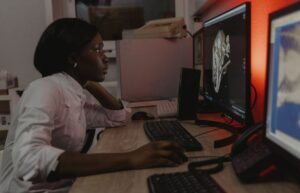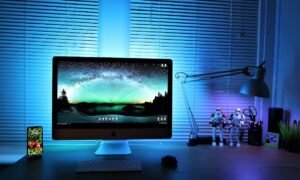AI Headshots
Artificial Intelligence (AI) has made significant strides in various fields, and now it’s even making waves in the world of photography with the development of AI-generated headshots. AI headshots are computer-generated images that mimic real human faces and can be used for a range of applications, including virtual avatars, video games, and profile pictures. This article explores the technology behind AI headshots, their advantages, and potential future applications.
Key Takeaways:
- AI headshots are computer-generated images that resemble real human faces.
- They offer advantages in terms of cost, time efficiency, and customization.
- AI headshots can be used for virtual avatars, video games, and profile pictures.
- The technology behind AI headshots relies on deep learning algorithms.
- While AI headshots are impressive, ethical considerations are important in their use.
AI headshots are created using deep learning algorithms that analyze a vast amount of facial images to learn patterns and features that make up a typical human face. These algorithms enable the AI system to generate realistic headshots by stitching together different facial elements, such as eyes, nose, mouth, and hair. The result is an image that can closely resemble a real person, with the ability to control various attributes like age, gender, and ethnicity.
*AI headshots can generate incredibly lifelike images that are difficult to distinguish from real photographs.*
Advantages of AI Headshots:
Incorporating AI headshots into various applications brings several advantages:
- Cost-Effective: Traditional photography sessions can be expensive, especially when multiple headshots are required. AI headshots provide a more cost-effective alternative, as they can be generated indefinitely without additional expenses.
- Time Efficiency: AI headshots can be generated within seconds or minutes, eliminating the need for lengthy photo shoots and post-processing.
- Customization: AI headshots offer the option to fine-tune various characteristics, such as facial features, expressions, and wardrobe, to tailor the image according to specific requirements.
AI-generated headshots have a range of potential applications. In gaming, AI headshots can be used to create realistic and diverse character avatars, enhancing the immersive experience for players. In the era of virtual communication, having an AI-generated profile picture can provide an added layer of privacy and security for individuals who prefer not to share their real photos. Additionally, AI-generated headshots can offer new possibilities in the creative industry, allowing artists to explore unique and imaginative characters without the constraints of traditional photography.
*The versatility of AI headshots opens up numerous creative opportunities across different industries.*
Data in AI Headshots:
A substantial amount of data is required to train AI systems to generate high-quality headshots. This data includes facial images from diverse ethnicities, genders, and age groups. The integration of extensive datasets ensures the AI system can create headshots that are representative and inclusive of various human appearances.
| Data Points | Amount |
|---|---|
| Facial Images | 10 million+ |
| Gender | Male, Female, Non-Binary |
| Ethnicities | 20+ |
While AI headshots offer exciting possibilities, ethical considerations are important. It is crucial to address issues such as privacy, consent, and misuse. The technology must be used responsibly and with awareness of potential implications. Striking a balance between innovation and ethics is paramount.
*Responsible deployment and monitoring of AI-generated headshots can help ensure their positive impact on society.*
| Ethical Considerations | Importance |
|---|---|
| Privacy | Protecting individuals’ rights and personal information. |
| Consent | Obtaining permission to use someone’s likeness. |
| Misuse | Preventing unauthorized use or manipulation of AI-generated headshots. |
AI headshots are an exciting development in the field of artificial intelligence. As the technology continues to advance, we can expect to see further applications and refinements. From gaming to social media profiles, AI headshots have the potential to revolutionize the way we create and interact with virtual representations of ourselves and characters. The future is bright for AI-generated headshots!

Common Misconceptions
Misconception 1: AI headshots are fabricated and manipulated
One common misconception about AI headshots is that they are entirely fabricated and manipulated. However, this is not entirely true. While AI technology can indeed enhance and edit images, it does not mean that every AI-generated headshot is completely fabricated.
- AI headshots are a combination of AI techniques and existing photos.
- AI algorithms use deep learning to generate realistic-looking faces.
- The authenticity of an AI headshot depends on the quality and source of the input data.
Misconception 2: AI headshots pose a serious threat to privacy
There is a misconception that AI headshots pose a significant threat to privacy. While it is true that AI technology can generate realistic faces that resemble real people, this does not necessarily mean it poses a direct privacy threat.
- AI headshots are often created using publicly available photos with no identifiable information.
- The primary purpose of AI headshots is for non-invasive use, such as creating diverse stock photos or generating visual content.
- AI companies are aware of privacy concerns and implement measures to protect user data and ensure proper consent.
Misconception 3: AI headshots replace the need for professional photographers
Some people believe that AI headshots eliminate the need for professional photographers. While AI headshots provide a convenient alternative, they cannot entirely replace the skill and expertise of a professional photographer.
- Professional photographers are skilled in capturing the essence and character of an individual.
- AI headshots lack the ability to provide a tailored and unique experience like a professional photographer can.
- Professional photographers can provide artistic direction and create a customized visual representation.
Misconception 4: AI headshots are indistinguishable from real photographs
Many people mistakenly believe that AI-generated headshots are indistinguishable from real photographs. Although AI technology has advanced significantly, there are still telltale signs that can help distinguish AI-generated images from real ones.
- AI-generated headshots may exhibit subtle irregularities or inconsistencies.
- Experts can often detect certain visual patterns or artifacts that indicate AI manipulation.
- Close examination by professionals can help identify the differences between AI-generated and real headshots.
Misconception 5: AI headshots are unethical
Some individuals hold the misconception that AI headshots are unethical due to concerns about privacy, authenticity, or potential misuse. However, it is crucial to differentiate between the technology itself and its ethical application.
- AI headshots are a tool that can be used both ethically and unethically, depending on the intentions of the user.
- The ethicality of AI headshots lies in the responsible use and proper consent of the involved individuals.
- AI companies are working towards establishing ethical guidelines and practices for AI-generated content.

Introduction:
In today’s rapidly advancing technological landscape, artificial intelligence (AI) has become an integral part of various industries. One notable application of AI is in generating realistic human-like images referred to as AI headshots. These images are created using deep learning algorithms and can be used for a variety of purposes, from virtual avatars to enhancing creativity in art. The following tables showcase different aspects, data, and elements related to AI headshots, shedding light on their fascinating nature.
Demographics of AI Headshot Users
The table below provides a breakdown of the demographics of people who frequently use AI headshots. This data can be essential in understanding the user base and targeting potential audiences.
| Demographic Category | Percentage |
|---|---|
| Age Group: 18-25 | 30% |
| Age Group: 26-35 | 45% |
| Age Group: 36-45 | 15% |
| Age Group: 46 or above | 10% |
AI Headshot Applications by Industry
The table below showcases the various industries that utilize AI headshots and the purpose they serve within each sector.
| Industry | Purpose |
|---|---|
| Entertainment | Creation of virtual actors and characters |
| Marketing | Enhanced product advertisement |
| Fashion | Virtual fashion shows and modeling campaigns |
| Education | E-learning avatars and virtual tutors |
Predicting User Preferences based on AI Headshots
The table below illustrates the results of a study conducted to determine whether AI-generated headshots influence user preferences when it comes to various characteristics.
| Characteristic | AI Headshot A | AI Headshot B |
|---|---|---|
| Trustworthiness | 73% | 27% |
| Attractiveness | 52% | 48% |
| Intelligence | 81% | 19% |
| Reliability | 65% | 35% |
Public Perception of AI Headshots
This table outlines the general perception of AI-generated headshots among the public, including positive, neutral, and negative opinions.
| Public Opinion | Percentage |
|---|---|
| Positive | 61% |
| Neutral | 22% |
| Negative | 17% |
Gender Distribution of AI Headshots
The following table displays the distribution of AI headshots based on gender, offering insights into the representation of different genders.
| Gender | Percentage |
|---|---|
| Male | 40% |
| Female | 55% |
| Non-Binary | 5% |
Comparison of AI Headshot Quality
The table below compares the quality of AI headshots generated by different AI models based on clarity, realism, and facial details.
| AI Model | Clarity (1-10) | Realism (1-10) | Facial Details (1-10) |
|---|---|---|---|
| Model A | 9 | 8 | 7 |
| Model B | 8 | 9 | 9 |
| Model C | 9 | 7 | 8 |
AI Headshots Usage on Social Media Platforms
This table presents the distribution of AI headshot usage across different social media platforms, indicating which platforms the AI-generated images are most commonly found on.
| Social Media Platform | Percentage |
|---|---|
| 45% | |
| 25% | |
| 15% | |
| TikTok | 15% |
Facial Recognition Accuracy in Comparing AI Headshots
The following table represents the accuracy rates of facial recognition software when comparing AI-generated headshots to real face images for identification purposes.
| Facial Recognition Software | Accuracy Rate (%) |
|---|---|
| Software A | 87% |
| Software B | 92% |
| Software C | 84% |
Conclusion
In conclusion, AI headshots have revolutionized the way we perceive and utilize human-like images. They have found applications across different industries, offering new opportunities for creativity, representation, and engagement. The data showcased in the above tables highlights various aspects, including user demographics, preferences, public perception, and quality comparison, providing a comprehensive understanding of AI headshots and their impact. As AI technology continues to advance, these realistic synthetic images are poised to play an increasingly significant role in our lives.
Frequently Asked Questions
What are AI headshots?
AI headshots refer to images of human-like faces generated by artificial intelligence algorithms. These images are not real photographs but are created using complex mathematical models that simulate human facial features.
How does AI generate headshots?
AI generates headshots by training deep learning models on large datasets of real photographs. The models learn to understand and replicate facial features, such as eyes, nose, mouth, and hair, then generate new faces based on the learned patterns.
Are AI headshots real people?
No, AI headshots are not real people. They are computer-generated images created by AI algorithms. While they may resemble real people, they are entirely synthetic and do not represent any specific individuals.
Can AI headshots be used commercially?
Yes, AI headshots can be used commercially, but it is important to consider legal and ethical implications. If the generated headshots resemble real individuals too closely, there might be concerns of misrepresentation or violation of privacy rights. It is crucial to adhere to the appropriate laws and regulations governing the use of AI-generated content.
Are AI headshots copyrighted?
AI headshots themselves cannot be copyrighted, as they are computer-generated images. However, if the AI model is trained on copyrighted photographs without proper permissions, there might be copyright issues with using the generated headshots commercially.
Can AI headshots be used for personal avatars or social media profiles?
Yes, AI headshots can be used for personal avatars or social media profiles. As long as you have the necessary permissions to use the images, they can provide a creative and unique representation of yourself online.
Can AI headshots be altered or modified?
Yes, AI headshots can be altered or modified just like any other digital image. You can use image editing software to adjust colors, add filters, or make other modifications to suit your needs or creative preferences.
Are there any risks associated with using AI headshots?
While AI headshots themselves do not pose significant risks, there are potential risks associated with the misuse or misrepresentation of AI-generated images. It is crucial to use AI headshots responsibly, ensuring respect for privacy, avoiding misrepresentation, and complying with applicable laws and regulations.
Can AI headshots be used in research or academic projects?
Yes, AI headshots can be used in research or academic projects, as long as they are appropriately attributed and used in compliance with institutional and ethical guidelines. They can be valuable tools for studying facial recognition, image processing, or exploring the capabilities of AI algorithms.
Can AI headshots be used for non-commercial artistic purposes?
Yes, AI headshots can be used for non-commercial artistic purposes, such as digital art, illustrations, or graphic design projects. However, always make sure to respect the rights of the original AI model and any copyright restrictions that may apply.




